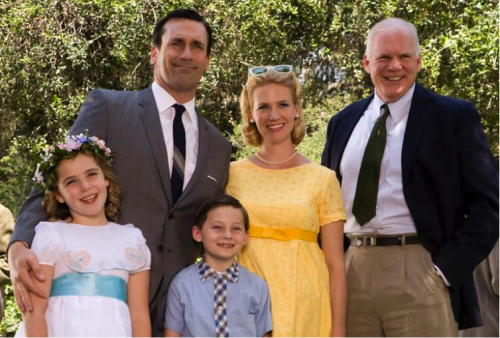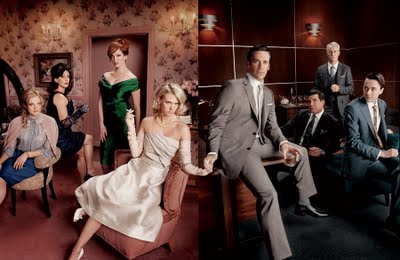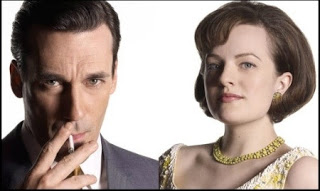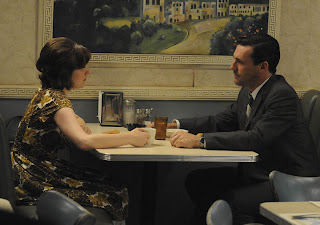This guest post by Caroline Madden appears as part of our theme week on Masculinity.
Mad Men’s leading ad man, Don Draper, started out as an enigmatic and virile figure–a creative genius on the top of his career who has a beautiful wife and family and an insatiable sexual appetite fulfilled by many other mistresses. Don Draper, for audiences and the characters that surrounded him alike, was the ultimate male figure. Characters around him constantly likened him to matinee idols such as James Garner and Gregory Peck, or an astronaut, and even Batman. Don is constantly seen by others as handsome yet inscrutable, as he swaggers around the office winning pitches and charming clients, yet remaining distant and unwilling to share anything personal. No one, whether it be the clients at work or the beautiful women he seduced, could resist the Don Draper charm. But the seemingly infallible wall and perfect image that surrounds Don slowly diminishes as the series goes on. And we learn that it is just that: an image.
We discover early on in the show that Don Draper is really Dick Whitman- a poor farm boy from Pennsylvania. His mother was a prostitute who died in childbirth, his father a cruel drunk who died in front of him after being kicked by a horse. Dick moved with his stepmother and grew up in a whorehouse. Dick then volunteered for the Korean War to get out of his home. He accidentally killed his C.O., the real Don Draper, and switched dog tags with him in order to start a new life under his name. Ever since then, Dick has been constantly trying to escape his past by reinventing himself as a new man–a man who has, as Peggy Olson notes in the episode “The Fog,” “everything, and so much of it.” The farm boy now has more money than he knows what to do with and a beautiful home and family. Don tries to live the picturesque life that he conjures up in advertisements. But like most of advertising itself, it is false. Despite his new start, Don cannot escape his past and issues, it is constantly bubbling over and seeping into his life. Don’s seemingly perfect family life and ways of self-medication is, how Pete Campbell reflects on in his own monologue, a “temporary bandage on a permanent wound.”
Mad Men has seven seasons, and is set across an entire decade from 1960 to 1970. The show is rampant with the gender stereotypes of the era, and they are especially visible in the first seasons. The sexist attitudes of the era are shown in the dialogue and depiction of office and family life; there are far too many examples to name. We see these gender stereotypes reflected again and again in the brainstorming and final fruition of advertisements that Sterling Cooper creates. However, not only does Mad Men tell the stories of people who live in that time period, but the characters and story also end up symbolizing the turmoil and transformations of the decade itself. Upon viewing the series after knowing the show’s finale, we see that the Don Draper arc reflects a small change in gender perspectives during that era. The Don of Season 1 would never act as the Don in the Season 7 finale. We see that Mad Men was all about shattering the hyper-masculine Don Draper mythos that he built and trapped himself within.
Throughout the series, we have seen Don reach several small epiphanies and seemingly making some progress, only to circle around and revert back in the end. Much like the Springsteen song, Don was constantly moving “one step up, and two steps back.” In Season 4, Don loses control of himself after his divorce from Betty. Most notably in the episode “Waldorf Stories,” Don gets blackout drunk and ends up sleeping with two women in one night. He also shows up at a meeting where he drunkenly and sloppily pitches to Life Cereal. He even references the notion of “nostalgia,” which pathetically evokes the most poignant pitch of his career for Kodak. This is not the cool, calm, and collected Don of Season 1. Don remarries Megan to get himself back on track, and for a while it works. In Season 5, he was able to remain faithful and cut back on drinking. He was open with her about his past as Dick Whitman, his relationship with Anna Draper, everything. But by Season 6 he is having an affair with his neighbor and drinking heavily again.
The culmination of Season 6 is a major collapse of Don’s masculine, perfected, and guarded image. The charm and swagger that used to work so well for his business is losing its power. During a pitch for Hershey, we see Don his most vulnerable in front of other men. At first, Don tells a fake story of how he would mow the lawn for his father and be rewarded with a Hershey bar. The executives are pleased; it’s the exactly what they want to hear. But it’s a lie. Then, Don decides to sell the truth for once. He confesses,
“I was an orphan. I grew up in Pennsylvania in a whorehouse. I read about Milton Hershey and his school in Coronet magazine or some other crap the girls left by the toilet. And I read that some orphans had a different life there. I could picture it. I dreamt of it. Of being wanted. Because the woman who was forced to raise me would look at me every day like she hoped I would disappear. Closest I got to feeling wanted was from a girl who made me go through her john’s pockets while they screwed. If I collected more than a dollar, she’d buy me a Hershey bar. And I would eat it alone in my room with great ceremony, feeling like a normal kid. It said ‘sweet’ on the package. It was the only sweet thing in my life.”
Don continues this reveal of his true self to the ones he owes it the most, his children. He takes his children to see the decrepit house he grew up in. He attempts to break the circle of this false identity he has built for so long.
Upon reflection, the breakdown of Don’s persona seems a clear journey for this character, but to many audience members it is hard to see Don in weaker moments. Many prefer seeing Don as the alpha male of Season 1. In Matthew Weiner’s interview with Hanna Rosin at The Atlantic they remark that the audience has trouble when Don loses his confidence. Rosin comments that the audience “Could tolerate his wickedness if he was alpha. But if he cried, or lost his bearings-” To which Weiner replies that there have been other ‘weak’ moments for Don on the show: “He’s cried before. He lost his bearings in the Carousel scene at the end of the first season. That’s the most famous moment in the show. He was filled with regret and weeping over something very, very un-masculine. He ran to Rachel Menken and said, ‘Let’s run away,’ and could not have been weaker.” But the Hershey moment was remarkably different than these moments.
In the Season 7 finale, for Don has to finally hit rock bottom in order to truly shed his false persona. Don has ended up in California at the Esalen Institute, a therapeutic treatment center. He did not go willingly, but was brought by his acquaintance, Anna Draper’s niece Stephanie. During a class in one exercise, you are told to face another person and physically communicate with them how they feel. Don remains guarded with his arms crossed and brow furrowed, a gesture certainly fitting. Don has long felt psychology was false and a waste of time, and this is no different. Sharing your feelings was seen as weak, and Don was always telling others to stop crying or grieving.
However, eventually Don has a nervous breakdown. The culmination of Stephanie leaving him, telling him he is not her family, and news of Betty dying leaves him paralyzed with emotion. He calls Peggy on the phone, who fears that he is near suicidal. “I messed everything up. I’m not the man you think I am. I broke all my vows. I scandalized my child. I took another man’s name and made nothing of it.” He confesses. A kind woman takes him to a group therapy session, but he can only sit in a trance. Then, a nebbish man Leonard sits a chair and begins opening up: “It’s like no one cares that I’m gone. They should love me. I mean, maybe they do, but I don’t even know what it is. You spend your whole life thinking you’re not getting it, people aren’t giving it to you. Then you realize they’re trying and you don’t even know what it is.” The beginning of his speech gets Don’s attention, and by the end Don is standing up and walking over to embrace the sobbing Leonard. This scene is incredibly important for Don Draper’s character arc.
Matthew Weiner remarked in his interview with the New York Public Library that they studied videos from Esalen: “These guys have had it. Even if they’re not veterans, they are just—the alienation that was created by success, political, racial tension, the technology, which is I think what’s happening right now, the isolation, these guys were like they’re going to crack, and it’s not like they haven’t always done that, but it was really something that I felt that was part of the story of the era of the sixties.” The era of the ’60s is ending, as well as Don’s journey. Don has had it; he has cracked and cannot take it any longer. The story of the characters end up reflecting the era they’re living in.
Don Draper is from The Silent Generation, where children were taught to be seen and not heard, especially male children. And especially Don, whose stepmother hated him. Boys were (and still are today) taught never to cry, or express their feelings. Being emotional is seen as being feminine, which men of that era would never want to be been seen as. It is a harmful stereotype for all men, leaving them stunted and suppressing their emotions. This expectation for men to remain these silent heroes, doubled by the false perfect persona that Dick Whitman puts on as Don Draper, is what leads him to make so many of his mistakes and fuels his turbulent emotional problems.
The Mad Men finale, as well as Don’s entire journey, demonstrates how destructive the rules of “being a man” can be. Especially during a time when sexism was so open, when the lines were so clearly drawn between what made a man and what made a woman. We had seen Don cry or open up emotionally a handful of times, but for the most part Don remained so closed off from everyone, folding his arms to the world. The finale shows the first time he finally opens them and embraces, both literally and figuratively, not only himself, but another man suffering the same problems as well. It is an incredibly important moment for Don. Don begins as a man unable to express himself and forced to uphold unwavering masculinity due to his upbringing, the era he lived in, and the persona he crafted for himself. He ends by rejecting those notions, which allows him to fully connect with others around him and make peace with his inner conflicts and past.
Caroline Madden has a BFA in Acting from Shenandoah Conservatory and is working on an MA in Cinema Studies at Savannah College of Art and Design. She writes about film at Geek Juice, Screenqueens, and her blog. You can usually find her watching movies or listening to Bruce Springsteen.










